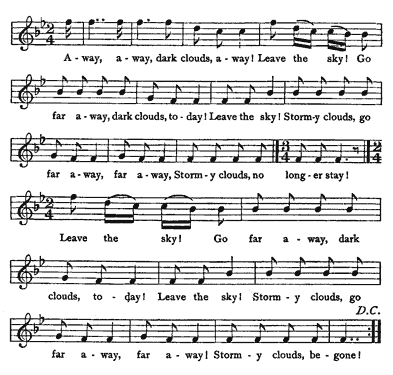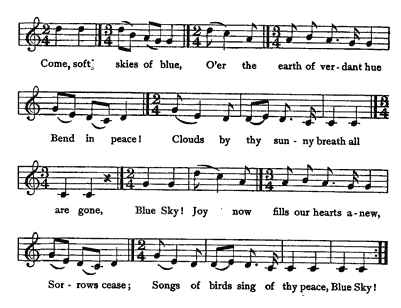Appeal for Clear Sky
by Alice C. Fletcher
INTRODUCTORY NOTE.—Among those Indian tribes that lived outside the semi-arid sections of our country, the storm with its destructive force was the representative of war, and thunder was a war god.
Warfare was widespread among the tribes dwelling in the Mississippi valley; yet among these people the desirability and value of peace were recognized. Honors won in a defensive fight gave the warrior higher rank than those gained in wars of aggression. Rituals belonging to religious ceremonies, and also to war rites, taught that the first duty of the warrior was to protect the women and children, the fields and the food supply, for his strong arm and ready courage made the tribe's only wall of defence against enemies.
These tribes had ceremonies relating to the maintenance of peace not only within the tribe but for the purpose of forming peaceful relations with other tribes. The clear sky was the symbol of peace, of happiness and of prosperity, conditions the very opposite of those that attended war.
When a peace ceremony was in progress, if a storm arose it was looked upon as an omen of disaster. At such a time, when clouds gathered, the people joined in ceremonial songs and appeals for clear sky, the symbol of peace.
The following dramatic dance and the accompanying songs are employed on such an occasion. The songs are taken from ceremonies used to promote peace.
Properties.—Staffs, about three feet long, with small blue flags, as many as there are dancers, the same number of blue head-bands and blue sashes. The latter are to be worn from the right shoulder across the breast and tied at the waist under the left arm. A drum.
Directions.—This dance belongs to both sexes and boys and girls should, if possible, join in it.
The Dance
All the dancers stand facing the East, in one or more rows deep, according to the number, their staffs held in the right hand so that the flags will hang in front of each dancer, covering the chest, as they begin the following song:
Song No. 1
Away, away, dark clouds, away!
Leave the sky!
Go far away, dark clouds, to-day!
Leave the sky!
Stormy clouds, go far away, far away,
Stormy clouds, no longer stay!
Leave the sky!
Go far away, dark clouds, to-day!
Leave the sky!
Stormy clouds, go far way, far away!
Stormy clouds, begone!

First Appeal
In the first line at each "away" the dancers should look up toward the East and move a step forward in that direction. At the line "Leave the sky!" they should point their flags toward the East, keeping the staff out on a level with the body, and accent it by thrusting it forward as if pointing to the East, being careful not to change the level of the staff. At the second "Leave the sky!" the level of the staffs must be raised to about the chin of the dancer and the same pointing motion repeated at this level. At the third "Leave the sky!" the staffs are raised to the level of the dancers' eyes and the same pointing movement repeated. At the fourth "Leave the sky!" the level of the staffs is raised to a line with the top of the head and the pointing motions again given. At the last line, "Stormy clouds, begone!" the staffs and flags should be raised aloft and waved with precision to the rhythm of the song. The steps and movements of the body should be that of backward and forward, to give a pulsating effect, all in exact time with the music. The drum should be beaten in 4/8 time, the first and third stroke heavier than the second and fourth. This series of movements constitutes the Appeal to the East.
The dancers next turn to the North, repeat the song and all the movements of staff and body in exactly the same manner.
The dancers now turn toward the West and go through the song and movements without any variation.
They then turn toward the South and repeat song and movements as before. This brings the First Appeal to a close.
Second Appeal
All the dancers gather in a loose group in the center of the open space, where they divide into two lines that must cross each other at right angles. When this cross-figure is formed, all, as they stand, should face the East. The staffs should be held at an angle similar to that of a baton and then swayed to the rhythm of the following song of pleading and of hope:
Song No. 2
Come, soft skies of blue,
O'er the earth of verdant hue
Bend in peace!
Clouds by thy sunny breath all are gone,
Blue Sky!
Joy now fills our hearts anew,
Sorrows cease;
Songs of birds sing of thy peace,
Blue Sky!

As the dancers sing they should take a step sidewise to the right, then return to the first position; then a step to the left and return, so that the whole cross-figure has a swaying motion accentuating the rhythm of the song, which should be sung smoothly and flowingly. When the words "Blue Sky!" are sung the flags should be raised aloft and waved in rhythm and then returned to the previous level. The song should be repeated several times and the figure maintained as the singers face the North, West, South and back to the East. Then the dancers should break into groups and, still singing the song and dancing rhythmically, disperse to their tents.